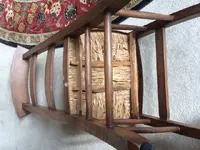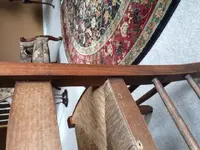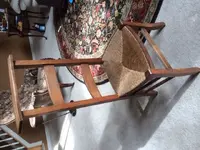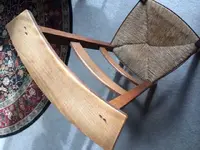Webster734
Tenderfoot
- Joined
- Sep 21, 2014
- Messages
- 4
- Reaction score
- 1
- Golden Thread
- 0
- Primary Interest:
- All Treasure Hunting
Any help identifying this chair age and/or geographic origin is appreciated!
I cant find anything similar online but I'm hoping someone's seen this before. The chair doesn't appear to be oak but some other light colored hardwood. The seat was especially interesting because of the support underneath.... I've not seen that before but clearly primitive with rough sawn and hand shaped wood. Height from floor to seat is about 14.75 inches. Total height of chair is approximately 38 inches. Width of seat in front is 15 inches and in the back it's 12.75 inches.
The original seat edge cover exists in the back only and is made of veneered wood inserted into tenon slots and nailed as shown in the picture. Side and front covers are old replacements made of some sort of composite board and aren't fastened, just slid into the tenon slots. Discolored nail holes can be seen behind these replacements and are consistent with the back cover configuration. This discoloration also leads me to believe the rush seat is the original. The top rail (laid horizontally on top) has also been repaired. The original rectangular head nails (as evidenced by the depressions still seen) have been replaced by round head nails at some point.
Another neat feature are the wormholes that exist everywhere on the chair. I think its seen some history but I'm having difficulty nailing it down. I appreciate any information anyone can provide!




I cant find anything similar online but I'm hoping someone's seen this before. The chair doesn't appear to be oak but some other light colored hardwood. The seat was especially interesting because of the support underneath.... I've not seen that before but clearly primitive with rough sawn and hand shaped wood. Height from floor to seat is about 14.75 inches. Total height of chair is approximately 38 inches. Width of seat in front is 15 inches and in the back it's 12.75 inches.
The original seat edge cover exists in the back only and is made of veneered wood inserted into tenon slots and nailed as shown in the picture. Side and front covers are old replacements made of some sort of composite board and aren't fastened, just slid into the tenon slots. Discolored nail holes can be seen behind these replacements and are consistent with the back cover configuration. This discoloration also leads me to believe the rush seat is the original. The top rail (laid horizontally on top) has also been repaired. The original rectangular head nails (as evidenced by the depressions still seen) have been replaced by round head nails at some point.
Another neat feature are the wormholes that exist everywhere on the chair. I think its seen some history but I'm having difficulty nailing it down. I appreciate any information anyone can provide!







